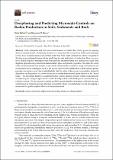| dc.contributor.author | Mehta, Neha | |
| dc.contributor.author | Kocar, Benjamin David | |
| dc.date.accessioned | 2018-06-25T17:23:34Z | |
| dc.date.available | 2018-06-25T17:23:34Z | |
| dc.date.issued | 2018-05 | |
| dc.date.submitted | 2018-05 | |
| dc.identifier.issn | 2571-8789 | |
| dc.identifier.uri | http://hdl.handle.net/1721.1/116566 | |
| dc.description.abstract | Soils, sediments and rock are natural sources of radon (Rn), which poses an ongoing threat to human health. Numerous studies have measured Rn release from bulk earth materials, yet few have examined microscale controls on Rn flux from solids (emanation), which is required to develop a process-based framework for predicting the rate and extent of production. Here, we use a novel closed loop flow-through system to measure Rn emanation from two crushed rock types with disparate physical and geochemical characteristics, shale and granitic pegmatite. We relate the extent of Rn emanation from each sample to microscale characteristics examined using conventional and synchrotron-based techniques, such as Rn parent radionuclide distribution within mineral grains, porosity, and surface area. Our results illustrate that the extent of Rn release from solids is primarily dependent on the position of parent radionuclides within host mineral grains relative to the “recoil range”—the maximum distance a daughter product (such as Rn) may traverse within a solid and into an adjacent pore owing to alpha-recoil—and is less dependent on the bulk parent radionuclide (e.g., radium) activity. We also present a simple model for predicting the emanation coefficient for pure solids based on mineralogical and physical parameters, which is an initial step toward developing a framework for predicting Rn efflux (exhalation) from soils. Keywords: radon; emanation; alpha-recoil; modeling; microscale characteristics | en_US |
| dc.publisher | Multidisciplinary Digital Publishing Institute (MDPI) | en_US |
| dc.relation.isversionof | http://dx.doi.org/10.3390/soilsystems2020030 | en_US |
| dc.rights | Creative Commons Attribution | en_US |
| dc.rights.uri | http://creativecommons.org/licenses/by/4.0/ | en_US |
| dc.source | Multidisciplinary Digital Publishing Institute | en_US |
| dc.title | Deciphering and Predicting Microscale Controls on Radon Production in Soils, Sediments and Rock | en_US |
| dc.type | Article | en_US |
| dc.identifier.citation | Mehta, Neha and Benjamin Kocar. "Deciphering and Predicting Microscale Controls on Radon Production in Soils, Sediments and Rock." Soil Systems 2, 2 (May 2018): 30 © 2018 The Authors | en_US |
| dc.contributor.department | Massachusetts Institute of Technology. Department of Civil and Environmental Engineering | en_US |
| dc.contributor.mitauthor | Mehta, Neha | |
| dc.contributor.mitauthor | Kocar, Benjamin David | |
| dc.relation.journal | Soil Systems | en_US |
| dc.eprint.version | Final published version | en_US |
| dc.type.uri | http://purl.org/eprint/type/JournalArticle | en_US |
| eprint.status | http://purl.org/eprint/status/PeerReviewed | en_US |
| dc.date.updated | 2018-06-25T07:43:07Z | |
| dspace.orderedauthors | Mehta, Neha; Kocar, Benjamin | en_US |
| dspace.embargo.terms | N | en_US |
| dc.identifier.orcid | https://orcid.org/0000-0002-7312-6398 | |
| mit.license | PUBLISHER_CC | en_US |
